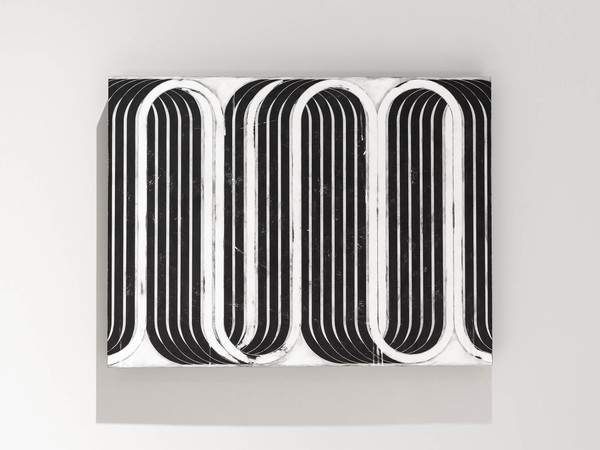Florence, at the Museo Novecento the young Davide Balliano dialogues with Arturo Martini
At the Museo del Novecento in Florence , the Duel cycle returns for the fifth time, with guest curators called upon from time to time to collaborate with artists active on the international scene to create site-specific interventions inspired by the museum’s collection. A dialectical duel between contemporary artists and civic heritage, which on this occasion features Davide Balliano (Turin, 1983) with the exhibition L’attesa (from June 7 to September 12, 2019), exceptionally curated by Museo Novecento artistic director Sergio Risaliti.
The exhibition stems from a dialogue with Arturo Martini ’s (Treviso, 1889 - Milan, 1947) sculpture Susanna (Treviso, 1889 - Milan, 1947) made around 1935 and develops around the theme of waiting. In its archaic flavor, the work strikes, according to Balliano, deep inside for its almost primitive features, but at the same time caresses the soul with an infinite sweetness, in perfect synchrony with its name: Susanna, Lily, symbol of purity. A meaning that also refers back to the city of Florence and modernism, recalls Risaliti, who has always looked to the purity of figurative language to avoid being overwhelmed by reality and history. The works that Davide Balliano deploys in a duel with Arturo Martini are a body of unpublished works, seven paintings and one sculpture, along with a series of photographs that testify to performances made in the past.
In dialogue with Martini’s Susanna, the artist exhibits a new sculpture made of mirror steel, hollow like a cylinder or vessel cut in half. “The steel reflects and incorporates with mirroring everything that appears in the space,” Risaliti explains. “And the container (formally a minimal and abstract work) although it cannot be filled with objects, things, people, is filled with reality thanks to the reflection of the metal. The sculpture also acts as a painting.” Indeed, all of Balliano’s research operates on the thin line between sculpture and painting, addressing existential and current issues, such as man’s identity in the age of technology and his relationship with the sublime, through an austere and minimal language built around abstract geometries in strong dialogue with architecture. “References to Minimalism and abstract vocabulary also return in the paintings, undergoing a sort of distortion in the direction of reality and existence from which Balliano does not want to separate or distance himself through the use of a cold and aseptic logic and language,” the director adds.
The young Italian artist, who has now lived in New York for twelve years, has established himself in international exhibitions thanks to work that ranges from performance to photography, from sculpture to painting. “My compositions, always based on a sober assonance of a few elements, often layered but never in perspective, are now animated by a constant vibration,” explains Davide Balliano. “A heartbeat, a repetitive and regenerative movement in which each element is similar but different. Like the minutes all the same spent waiting, understanding and thinking. Instead, the sculpture has cooled, losing the organic warmth of the ceramic. The result was a cold, monolithic, mirror-like object. A concave form, which I feel is like an architecture containing a central silence. A chimney built to describe the column of emptiness that supports it. And this form contains, collects and somehow responds, returning our gaze. Like a sphinx that answers our questions with steady, inscrutable eyes. This is the beating heart of the exhibition, the central tension on which each element revolves. This pillar of icy, neutral metal is the gaze that stares at Susanna, the source of the answers so longed for, the end of The Waiting. The pictorial elements and the sculpture are my new contribution to this exhibition, the legions I bring to my duel with Martini.”
Completing the exhibition are photographs that bear witness to three separate actions part of a single project Giving my back to the night I heard you lying to a giant: a reflection on the mystery of waiting for sleep. A daily moment when we prepare to give up all that we are, letting loose the control of our body, rational thought and the principle that binds cause and effect, breaking into the madness that is of dreams.
Originally trained in photography, Davide Balliano came to painting and sculpture practice in 2006 during his move to New York, where he currently lives and works.
His recent solo exhibitions include those at: Dirimart Gallery, Istanbul (2019), Tina Kim Gallery, New York (2019 and 2017), Museo Marca, Catanzaro (2018), 39 Great Jones, New York (2018), Luce Gallery, Turin (2017 and 2015), Timothy Taylor Gallery, London (2015), Room East, New York (2014), Rolando Anselmi Galerie, Berlin (2014 and 2012), Galerie Michael Rein, Paris (2013), Location One, New York (2011), The Artists Space, New York (2009). His works have been shown in numerous group exhibitions including those at: David
Zwirner Gallery, New York (2015), Sean Kelly Gallery, New York (2014 and 2010), Museo Madre, Naples (2012), The Watermill Center, New York (2011 and 2009), MoMA PS1, New York (2010), Espace d’Art Contemporain de Castello, Castellon, Spain (2010).
For all information you can visit the official website of the Museo Novecento.
Pictured: an untitled work by the artist from Tina Kim Gallery, New York.
Source: press release
 |
| Florence, at the Museo Novecento the young Davide Balliano dialogues with Arturo Martini |
Warning: the translation into English of the original Italian article was created using automatic tools. We undertake to review all articles, but we do not guarantee the total absence of inaccuracies in the translation due to the program. You can find the original by clicking on the ITA button. If you find any mistake,please contact us.



























